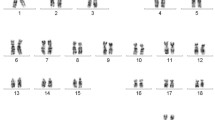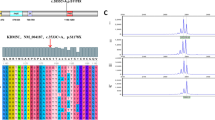Abstract
Xq28 microduplications of MECP2 are a prominent cause of a severe syndromic form of intellectual disability (ID) in males. Females are usually unaffected through near to complete X-inactivation of the aberrant X chromosome (skewing). In rare cases, affected females have been described due to random X-inactivation. Here, we report on two female patients carrying de novo MECP2 microduplications on their fully active X chromosomes. Both patients present with ID and additional clinical features. Mono-allelic expression confirmed complete skewing of X-inactivation. Consequently, significantly enhanced MECP2 mRNA levels were observed. We hypothesize that the cause for the complete skewing is due to a more harmful mutation on the other X chromosome, thereby forcing the MECP2 duplication to become active. However, we could not unequivocally identify such a second mutation by array-CGH or exome sequencing. Our data underline that, like in males, increased MECP2 dosage in females can contribute to ID too, which should be taken into account in diagnostics.




Similar content being viewed by others
References
Adkins NL, Georgel PT (2011) MeCP2: structure and function. Biochem Cell Biol 89:1–11
Allen RC, Zoghbi HY, Moseley AB, Rosenblatt HM, Belmont JW (1992) Methylation of HpaII and HhaI sites near the polymorphic CAG repeat in the human androgen-receptor gene correlates with X chromosome inactivation. Am J Hum Genet 51:1229–1239
Auber B, Burfeind P, Thiels C, Alsat EA, Shoukier M, Liehr T, Nelle H, Bartels I, Salinas-Riester G, Laccone F (2010) An unbalanced translocation resulting in a duplication of Xq28 causes a Rett syndrome-like phenotype in a female patient. Clin Genet 77:593–597
Bauters M, Van Esch H, Friez MJ, Boespflug-Tanguy O, Zenker M, Vianna-Morgante AM, Rosenberg C, Ignatius J, Raynaud M, Hollanders K, Govaerts K, Vandenreijt K, Niel F, Blanc P, Stevenson RE, Fryns JP, Marynen P, Schwartz CE, Froyen G (2008) Nonrecurrent MECP2 duplications mediated by genomic architecture-driven DNA breaks and break-induced replication repair. Genome Res 18:847–858
Bijlsma EK, Collins A, Papa FT, Tejada MI, Wheeler P, Peeters EA, Gijsbers AC, van de Kamp JM, Kriek M, Losekoot M, Broekma AJ, Crolla JA, Pollazzon M, Mucciolo M, Katzaki E, Disciglio V, Ferreri MI, Marozza A, Mencarelli MA, Castagnini C, Dosa L, Ariani F, Mari F, Canitano R, Hayek G, Botella MP, Gener B, Minguez M, Renieri A, Ruivenkamp CA (2012) Xq28 duplications including MECP2 in five females: expanding the phenotype to severe mental retardation. Eur J Med Genet 55:404–413
Bittel DC, Theodoro MF, Kibiryeva N, Fischer W, Talebizadeh Z, Butler MG (2008) Comparison of X-chromosome inactivation patterns in multiple tissues from human females. J Med Genet 45:309–313
Boonyawat B, Dhanraj S, Al AF, Zlateska B, Grunenbaum E, Roifman CM, Steele L, Meyn S, Blanchette V, Scherer SW, Swierczek S, Prchal J, Zhu Q, Torgerson TR, Ochs HD, Dror Y (2013) Combined de-novo mutation and non-random x-chromosome inactivation causing Wiskott–Aldrich syndrome in a female with thrombocytopenia. J Clin Immunol 33:1150–1155
Bouwman MG, Rombach SM, Linthorst GE, Poorthuis BJ, Deprez RH, Aerts JM, Wijburg FA (2011) Early cerebral manifestations in a young female with Fabry disease with skewed X-inactivation. Clin Genet 80:500–502
Carrel L, Willard HF (1996) An assay for X inactivation based on differential methylation at the fragile X locus, FMR1. Am J Med Genet 64:27–30
Collins AL, Levenson JM, Vilaythong AP, Richman R, Armstrong DL, Noebels JL, David SJ, Zoghbi HY (2004) Mild overexpression of MeCP2 causes a progressive neurological disorder in mice. Hum Mol Genet 13:2679–2689
Daza-Cajigal V, Martinez-Pomar N, Garcia-Alonso A, Heine-Suner D, Torres S, Vega AK, Molina IJ, Matamoros N (2013) X-linked thrombocytopenia in a female with a complex familial pattern of X-chromosome inactivation. Blood Cells Mol Dis 51:125–129
De La Fuente R, Baumann C, Viveiros MM (2011) Role of ATRX in chromatin structure and function: implications for chromosome instability and human disease. Reproduction 142:221–234
del Gaudio D, Fang P, Scaglia F, Ward PA, Craigen WJ, Glaze DG, Neul JL, Patel A, Lee JA, Irons M, Berry SA, Pursley AA, Grebe TA, Freedenberg D, Martin RA, Hsich GE, Khera JR, Friedman NR, Zoghbi HY, Eng CM, Lupski JR, Beaudet AL, Cheung SW, Roa BB (2006) Increased MECP2 gene copy number as the result of genomic duplication in neurodevelopmentally delayed males. Genet Med 8:784–792
DePristo MA, Banks E, Poplin R, Garimella KV, Maguire JR, Hartl C, Philippakis AA, del Angel G, Rivas MA, Hanna M, McKenna A, Fennell TJ, Kernytsky AM, Sivachenko AY, Cibulskis K, Gabriel SB, Altshuler D, Daly MJ (2011) A framework for variation discovery and genotyping using next-generation DNA sequencing data. Nat Genet 43:491–498
Froyen G, Corbett M, Vandewalle J, Jarvela I, Lawrence O, Meldrum C, Bauters M, Govaerts K, Vandeleur L, Van Esch H, Chelly J, Sanlaville D, van Bokhoven H, Ropers HH, Laumonnier F, Ranieri E, Schwartz CE, Abidi F, Tarpey PS, Futreal PA, Whibley A, Raymond FL, Stratton MR, Fryns JP, Scott R, Peippo M, Sipponen M, Partington M, Mowat D, Field M, Hackett A, Marynen P, Turner G, Gecz J (2008) Submicroscopic duplications of the hydroxysteroid dehydrogenase HSD17B10 and the E3 ubiquitin ligase HUWE1 are associated with mental retardation. Am J Hum Genet 82:432–443
Gonzales ML, LaSalle JM (2010) The role of MeCP2 in brain development and neurodevelopmental disorders. Curr Psychiatry Rep 12:127–134
Grasshoff U, Bonin M, Goehring I, Ekici A, Dufke A, Cremer K, Wagner N, Rossier E, Jauch A, Walter M, Bauer C, Bauer P, Horber K, Beck-Woedl S, Wieczorek D (2011) De novo MECP2 duplication in two females with random X-inactivation and moderate mental retardation. Eur J Hum Genet 19:507–512
Hagberg BA, Skjeldal OH (1994) Rett variants: a suggested model for inclusion criteria. Pediatr Neurol 11:5–11
Hagberg B, Aicardi J, Dias K, Ramos O (1983) A progressive syndrome of autism, dementia, ataxia, and loss of purposeful hand use in girls: Rett’s syndrome: report of 35 cases. Ann Neurol 14:471–479
Juan-Mateu J, Rodriguez MJ, Nascimento A, Jimenez-Mallebrera C, Gonzalez-Quereda L, Rivas E, Paradas C, Madruga M, Sanchez-Ayaso P, Jou C, Gonzalez-Mera L, Munell F, Roig-Quilis M, Rabasa M, Hernandez-Lain A, Diaz-Manera J, Gallardo E, Pascual J, Verdura E, Colomer J, Baiget M, Olive M, Gallano P (2012) Prognostic value of X-chromosome inactivation in symptomatic female carriers of dystrophinopathy. Orphanet J Rare Dis 7:82
Kirk EP, Malaty-Brevaud V, Martini N, Lacoste C, Levy N, Maclean K, Davies L, Philip N, Badens C (2009) The clinical variability of the MECP2 duplication syndrome: description of two families with duplications excluding L1CAM and FLNA. Clin Genet 75:301–303
Kloska A, Jakobkiewicz-Banecka J, Tylki-Szymanska A, Czartoryska B, Wegrzyn G (2011) Female Hunter syndrome caused by a single mutation and familial XCI skewing: implications for other X-linked disorders. Clin Genet 80:459–465
Lepage JF, Hong DS, Mazaika PK, Raman M, Sheau K, Marzelli MJ, Hallmayer J, Reiss AL (2013) Genomic imprinting effects of the X chromosome on brain morphology. J Neurosci 33:8567–8574
Li H, Durbin R (2010) Fast and accurate long-read alignment with Burrows–Wheeler transform. Bioinformatics 26:589–595
Makrythanasis P, Moix I, Gimelli S, Fluss J, Aliferis K, Antonarakis SE, Morris MA, Bena F, Bottani A (2010) De novo duplication of MECP2 in a girl with mental retardation and no obvious dysmorphic features. Clin Genet 78:175–180
Mayo S, Monfort S, Rosello M, Orellana C, Oltra S, Armstrong J, Catala V, Martinez F (2011) De novo interstitial triplication of MECP2 in a girl with neurodevelopmental disorder and random X chromosome inactivation. Cytogenet Genome Res 135:93–101
Menten B, Maas N, Thienpont B, Buysse K, Vandesompele J, Melotte C, de Ravel T, Van Vooren S, Balikova I, Backx L, Janssens S, De Paepe A, De Moor B, Moreau Y, Marynen P, Fryns JP, Mortier G, Devriendt K, Speleman F, Vermeesch JR (2006) Emerging patterns of cryptic chromosomal imbalance in patients with idiopathic mental retardation and multiple congenital anomalies: a new series of 140 patients and review of published reports. J Med Genet 43:625–633
Morey C, Avner P (2011) The demoiselle of X-inactivation: 50 years old and as trendy and mesmerising as ever. PLoS Genet 7:e1002212
Nesterova TB, Johnston CM, Appanah R, Newall AE, Godwin J, Alexiou M, Brockdorff N (2003) Skewing X chromosome choice by modulating sense transcription across the Xist locus. Genes Dev 17:2177–2190
Orstavik KH (2009) X chromosome inactivation in clinical practice. Hum Genet 126:363–373
Pina-Aguilar RE, Zaragoza-Arevalo GR, Rau I, Gal A, Alcantara-Ortigoza MA, Lopez-Martinez MS, Santillan-Hernandez Y (2013) Mucopolysaccharidosis type II in a female carrying a heterozygous stop mutation of the iduronate-2-sulfatase gene and showing a skewed X chromosome inactivation. Eur J Med Genet 56:159–162
Plenge RM, Hendrich BD, Schwartz C, Arena JF, Naumova A, Sapienza C, Winter RM, Willard HF (1997) A promoter mutation in the XIST gene in two unrelated families with skewed X-chromosome inactivation. Nat Genet 17:353–356
Plenge RM, Stevenson RA, Lubs HA, Schwartz CE, Willard HF (2002) Skewed X-chromosome inactivation is a common feature of X-linked mental retardation disorders. Am J Hum Genet 71:168–173
Ramocki MB, Peters SU, Tavyev YJ, Zhang F, Carvalho CM, Schaaf CP, Richman R, Fang P, Glaze DG, Lupski JR, Zoghbi HY (2009) Autism and other neuropsychiatric symptoms are prevalent in individuals with MeCP2 duplication syndrome. Ann Neurol 66:771–782
Ramocki MB, Tavyev YJ, Peters SU (2010) The MECP2 duplication syndrome. Am J Med Genet A 152A:1079–1088
Reardon W, Donoghue V, Murphy AM, King MD, Mayne PD, Horn N, Birk ML (2010) Progressive cerebellar degenerative changes in the severe mental retardation syndrome caused by duplication of MECP2 and adjacent loci on Xq28. Eur J Pediatr 169:941–949
Scott SJ, Laffin J, Haun J, Raca G, Friez MJ, Giampietro PF (2014) MECP2 duplication: possible cause of severe phenotype in females. Am J Med Genet A 164:1029–1034
Shimada S, Okamoto N, Hirasawa K, Yoshii K, Tani Y, Sugawara M, Shimojima K, Osawa M, Yamamoto T (2013a) Clinical manifestations of Xq28 functional disomy involving MECP2 in one female and two male patients. Am J Med Genet A 161A:1779–1785
Shimada S, Okamoto N, Ito M, Arai Y, Momosaki K, Togawa M, Maegaki Y, Sugawara M, Shimojima K, Osawa M, Yamamoto T (2013b) MECP2 duplication syndrome in both genders. Brain Dev 35:411–419
Skuse DH, James RS, Bishop DV, Coppin B, Dalton P, Aamodt-Leeper G, Bacarese-Hamilton M, Creswell C, McGurk R, Jacobs PA (1997) Evidence from Turner’s syndrome of an imprinted X-linked locus affecting cognitive function. Nature 387:705–708
Tang SS, Fernandez D, Lazarou LP, Singh R, Fallon P (2012) MECP2 triplication in 3 brothers - a rarely described cause of familial neurological regression in boys. Eur J Paediatr Neurol 16:209–212
Van Esch H (2012) MECP2 Duplication Syndrome. Mol Syndromol 2:128–136
Van Esch H, Bauters M, Ignatius J, Jansen M, Raynaud M, Hollanders K, Lugtenberg D, Bienvenu T, Jensen LR, Gecz J, Moraine C, Marynen P, Fryns JP, Froyen G (2005) Duplication of the MECP2 region is a frequent cause of severe mental retardation and progressive neurological symptoms in males. Am J Hum Genet 77:442–453
Acknowledgments
The authors thank the family members for their willingness to contribute to this research project. We are grateful to the excellent technical assistance of Karen Govaerts (KU Leuven, Belgium). This work was supported by grants from the VIB (Vlaams Instituut voor Biotechnologie), the Geconcerteerde Onderzoeks Acties (GOA) of the University of Leuven [grant number GOA/12/015 to GF], and from the Belgian Science Policy Office Interuniversity Attraction Poles (BELSPO-IAP) programme [grant number IAP P7/43-BeMGI to GF]. NF is a PhD fellow from the IWT (Agentschap voor Innovatie door Wetenschap en Technologie), Belgium. MB is a post-doctoral fellow and EDB is senior clinical investigator of the Fund for Scientific Research (FWO) Vlaanderen, Belgium.
Conflict of interest
The authors declare no conflict of interest.
Author information
Authors and Affiliations
Corresponding author
Electronic supplementary material
Below is the link to the electronic supplementary material.
Rights and permissions
About this article
Cite this article
Fieremans, N., Bauters, M., Belet, S. et al. De novo MECP2 duplications in two females with intellectual disability and unfavorable complete skewed X-inactivation. Hum Genet 133, 1359–1367 (2014). https://doi.org/10.1007/s00439-014-1469-6
Received:
Accepted:
Published:
Issue Date:
DOI: https://doi.org/10.1007/s00439-014-1469-6




